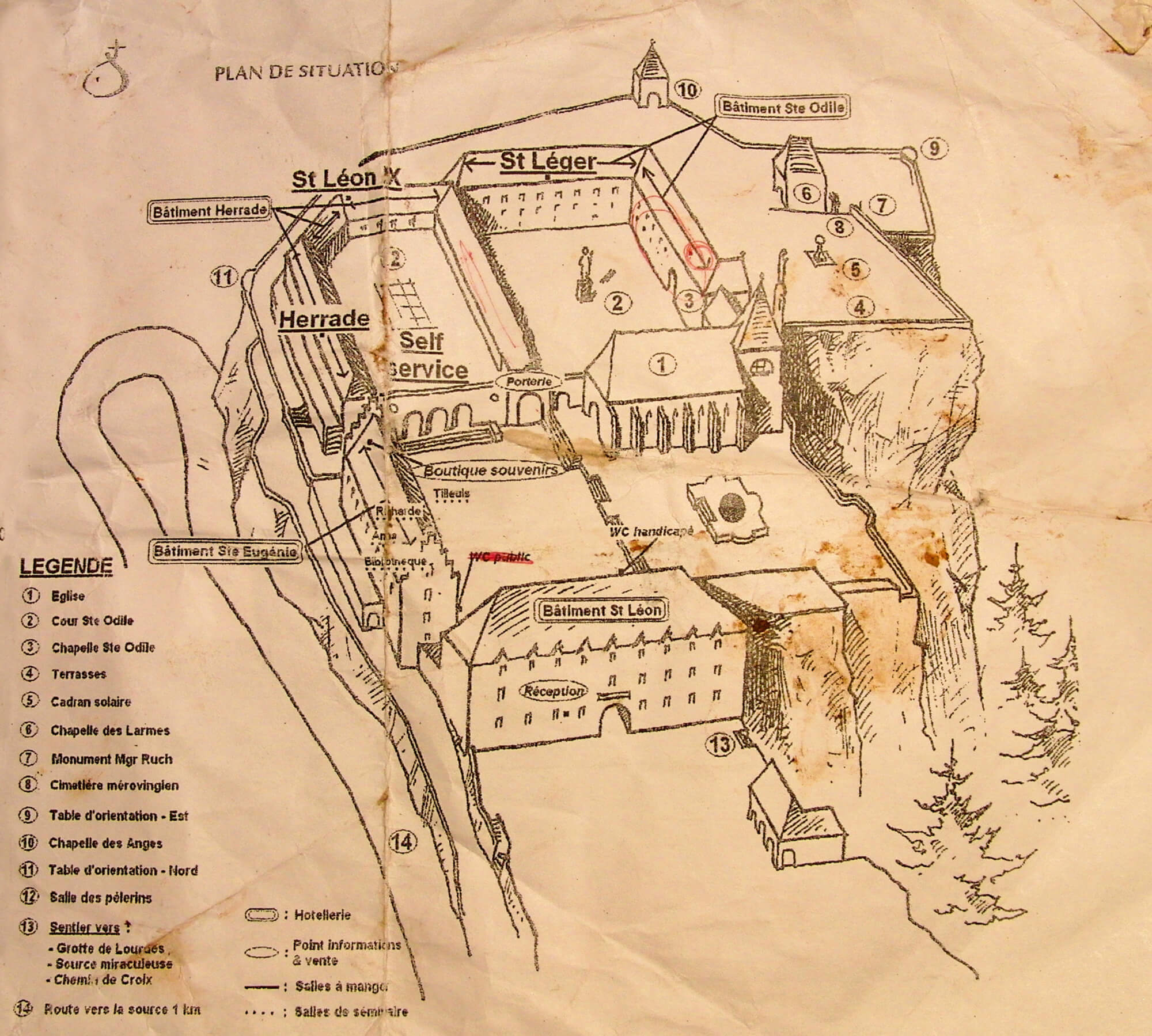Inside Jobs
Burrowing for books
Geoff Manaugh

The books and manuscripts were disappearing from a room no one seemed to be entering. Its doors were almost never opened, the room itself closed to public view. There was no believable explanation for where the materials might be going, so the least believable reasoning soon took hold. It was the work of the devil, the residents said. A poltergeist. A symbolic act of God meant to communicate something, if only they could interpret the signs.
This was, after all, a monastery—indeed, one of the world’s most picturesque, Mont Sainte-Odile, perched high in the mountains of France, nearly on the border with Germany—and its library was vanishing into thin air. A manuscript here, a bound volume there; five, six, a dozen, all quickly adding up to nearly a thousand key pieces of church scholarship missing from the shelves and tables.
When the police were finally notified, they chose not to perform an exorcism. Being a secular institution, they instead installed a hidden surveillance camera, and, in May 2002, the truth came to light. It was not a ghost at all, but an engineering teacher from Strasbourg. He had been entering the room through a long-forgotten secret passage, access to which was hidden inside one of the bookcases. Unseen—indeed entirely unsuspected—he was able to remove the library’s priceless collection piece by piece, emerging from the walls to take entire shelves of books at a time.
Perhaps more spectacular than the teacher’s indirect method of approach was how he came to know the passage was there in the first place. According to the Guardian, this otherwise law-abiding engineer first learned about the route “after discovering a forgotten map in public archives” revealing how the monastery’s attic was covertly joined to the library on a lower floor. This chance discovery of a discarded floor plan made him one of the very few people in the world who knew the architectural connection existed at all; it had long ago ceased being used by the monks themselves, having fallen into a state of neglect resembling spatial hibernation.
Bringing the passage back into service as a reliable form of internal circulation was not, in fact, easy. According to some newspaper accounts, doing so required scaling the outside walls of the monastery, then navigating a precipitous attic stairway. According to others, the man posed as an overnight guest staying in another part of the monastery that had been converted into a hotel; carrying a suitcase, he would slip into a room with access to a hidden passageway, climb down a rope ladder, then enter the library through the trick bookcase. Some reports also claim that he had to locate “a hidden mechanism” tucked inside the wall that would cause the back of the bookcase to flip open, allowing entrance into the library. Regardless of how he ultimately gained access to the books, his actions transformed the confines of the monastery into a kind of three-dimensional puzzle. Indeed, the very fact that these accounts diverge suggests something of an epistemological uncertainty at the heart of such crimes: that a burglar can misuse a piece of architecture so radically it becomes almost impossible to narrate what actually took place there.

Half a world away, another prolific book thief found equally furtive ingress through similar spatial means. An avid lock picker, expert counterfeiter, and methodical planner committed to researching the targets of his heists, Stephen Blumberg stole an estimated twenty million dollars’ worth of rare books and manuscripts from institutional archives and academic libraries around the United States. His plan for hitting the rare books collection of the University of Southern California in Los Angeles was characteristic: researching the history of the building, Blumberg had learned that a series of disused dumbwaiters had once functioned to deliver books between floors. The dumbwaiters were no longer active, but the shafts inside the walls of the library still offered a direct connection to book stacks that were otherwise inaccessible to the public.
Blumberg rightfully concluded that the shafts—like the M. C. Escher-like loop hidden inside the walls of Mont Sainte-Odile, connecting the monastery’s attic to the back of a cabinet—were effectively an alternative circulation system hiding in plain sight. Moreover, he reasoned, the passageways themselves would receive little attention from the building’s security team, which, in any case, most likely amounted to an underpaid student cramming for an exam at one of the exit doors. No alarms, no cameras, just narrow, chimney-like chutes invisible to outside view through which Blumberg could shimmy his way to treasure. And shimmy he did, successfully raiding the building from within. He got away with it, we might say, by going further inside, squeezing through the walls like a spider. Finally, having crawled back out through the dumbwaiter system, he would simply conceal his chosen books beneath an overcoat and walk calmly out the library’s front door.
Each of these crimes was made possible by the reawakening of a dormant interior, one disguised by and simultaneous with the buildings’ visible rooms. There was another building inside each building, we might say, a deeper interior within the interior. Their burglaries thus both depended on and operated through an act of spatial revelation: bringing to light illicit connections between two internal points previously seen as separate.
Indeed, in both cases the actual theft of books seems strangely anticlimactic, even boring, merely a graduated form of shoplifting. Rather, it is the way these crimes were committed that bears such sustained consideration. The burglars’ rehabilitation of a quiescent architectural space brings with it a much broader and more troubling implication that we ourselves do not fully understand the extent of the rooms and corridors around us, that the walls we rely on for solidity might in fact be hollow, and that there are ways of moving through any building, passing from one floor to another, that are so architecturally unexpected as to bear comparison to animal life or even the supernatural. In the end, burglars—dark figures burrowing along the periphery of the world—need not steal a thing to accomplish their most unsettling revelation.
Geoff Manaugh is a New York–based freelance writer who publishes widely on questions of landscape, architecture, and technology. He is the author of the forthcoming A Burglar’s Guide to the City (Farrar, Straus and Giroux, 2016), a study of the relationship between crime and the built environment. Previously, he was director of Studio-X New York, an off-campus urban think tank run by the architecture department at Columbia University.
Spotted an error? Email us at corrections at cabinetmagazine dot org.
If you’ve enjoyed the free articles that we offer on our site, please consider subscribing to our nonprofit magazine. You get twelve online issues and unlimited access to all our archives.